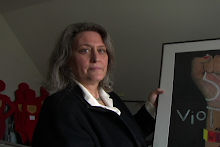Among the alternative approaches that are being developed by domestic violence advocates, probably the most talked about is “restorative justice,” which brings together batterers and survivors in an attempt to prevent further abuse.
Some view restorative justice as an alternative to jail sentences or batterer programs -- others see it as a supplement. It’s controversial. There’s a great deal of apprehension about restorative justice. Particularly when it’s presented as an alternative to the criminal justice-based response that’s been established as a result of the determined efforts of the battered women’s movement.
Yesterday we had an opportunity to observe one variant of restorative justice, an approach called “surrogate dialogue.” In these dialogues, a carefully prepared survivor is paired with a carefully prepared batterer -- both strangers to each other until the day of the dialogue. They go into a room together, along with the facilitators who worked with them in advance. They both tell their stories. They ask each other questions. The idea is to help the survivor continue to heal, feel empowered and listen, and to allow the batterer to achieve perspective on what he’s done.
Cathryn Curley of the Safe Haven Shelter in Duluth and Terry Fawcett of Duluth’s probation department organized this dialogue. It’s their fourth. They imported the idea from Hillsboro, Oregon, where the concept was developed by two domestic violence advocates at the Domestic Violence Surrogate program. The dialogues seek to “ generate understanding between the victim and offender as to each other's views and attitudes, as well as focus on the many consequences of domestic violence.”
In a phone interview this afternoon, Curley told us about the survivor’s reaction to the dialogue experience. She told Curley: “It was so healing for me, because he actually had empathy for me. He wasn’t my abuser, but he is an abuser.” Curley is also involved in another aspect of restorative justice -- sentencing circles. In these sessions, the offenders sit in a circle with community members for a dialogue that serves as an extension of any sentence that is meted out by the courts.
Camera person Alex Horner taped yesterday’s dialogue -- the session lasted for more than three hours. Stay tuned -- in coming months, we expect to post partial excerpts and transcripts of yesterday dialogue.
A Response from Anne Paulle
I think that perhaps the greatest irony in regard to domestic violence is that victim blaming revolves around excoriating DV victims for believing batterers while persons responding to DV -- lawyers, judges, health care professionals, clergy neighbors, Chris Brown enthusiasts-believe batterers all the time.
"Empathy" is a fluid, catalytic emotion: Receiving it can feel like fresh mountain water to somebody who is dying of thirst-- and leave one wanting more. Battered women's support and empowerment groups are more substantive with far fewer dangers and no specter of manipulation at all. Batterers routinely manipulate empathy: Any battered women's support group from Manila to the South Bronx, Shaker Heights OH to Birmingham UK will confirm batterer empathy manipulations.... and the support group's validation does not hold dangers for DV survivors.
I think that the most universally quoted data--I do not know exactly where it started--is that "studies show" that DV victims return to batterers six to seven times. Restorative justice initiatives support this reunification based on the emotional power of empathy.
But make no mistake, when battered women, validated through the empathy of restorative justice, return to the men who frighten,dominate and abuse them, we will blame them anyway.
Anne Paulle
Chair, "Power and Control" Board of Advisers
Subscribe to:
Post Comments (Atom)








Hi,
ReplyDeleteI look forward to seeing this film. Congratulations on the great work you are doing. From the clips and trailers it looks good.
I also want to tell you that on the side bar you say the photo has captured Duluth on a uncharacteristically beautiful day. Duluth is characteristically a beautiful city. In fact we even have a blog here named Perfect Duluth Day
http://www.perfectduluthday.com/
Hello - I am a restorative justice practitioner. I would like to clarify that 'reunification' is not a goal of RJ. Victim centered approaches - that promote healing.
ReplyDeleteRestorative Justice can be part of diversion or prison, it's a overarching philosophy not a simple treatment or intervention. When victims request restorative justice, and the desire to address issues like Domestic Violence, Severe crime and violence - working together, preparing to the nuances of each type of crime, promotes effective healing.
The Domestic Violence Surrogate program - and I've met founder Carrie Banks - addresses some of those concerns. A woman does not meet with her abuser. She meets with someone else whose mouth has spit the same poison. It looks like the healing benefits for women doing this type of process - are outweighing our fears she may return. In fact she may have returned without a restorative intervention - based on the statistic mentioned.
In my opinion - domestic violence/child abuse/sexual assualt - we are focusing on legal aspects. Protection orders, evidence collection, prosecution - although very important, what about treating the whole person the humanistic aspects. I think your film will be valuable in discussions and humanizing the issues. Transforming the culture the sustains abuse. All the best!
Kris
Thank you, no one should ever have to be afraid of someone who once told them "I love you"
ReplyDeleteMy story www.hereallalong.blogspot.com
Thank you for helping to bring awareness.
Lori